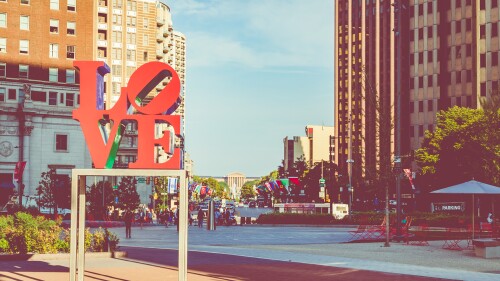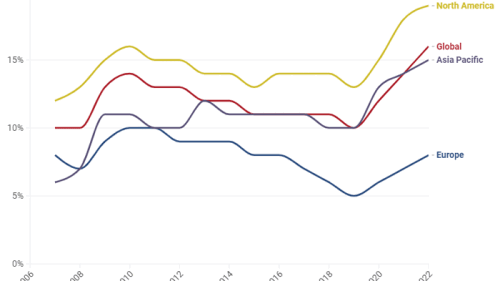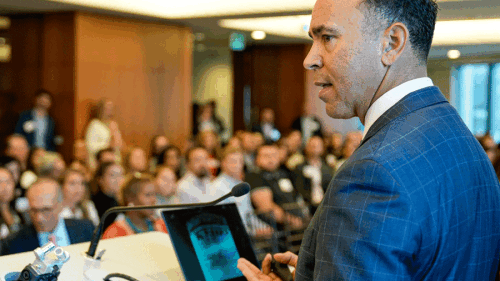This article appeared in the 2020 Fall issue of Urban Land on page 56.
How can the real estate development industry more successfully prepare for, navigate, and adapt to adverse events?
ULI MEMBER-ONLY CONTENT: Members of several of ULI’s product councils discuss resilience strategies, the impact of COVID-19, the role of state and local governments in working with the private sector to promote resilience, and other related trends.
If you are interested in applying to become a member of an Americas Product Councils, visit Navigator to learn more or submit your statement of interest
How are you approaching resilience in your work?
Elizabeth Shreeve: Our emphasis is on embracing green infrastructure and landscape infrastructure to make use of systems that our communities already have in place so that they serve multiple functions. For example, Buffalo Bayou Park in Houston offers flood control, filters stormwater, and provides a recreational resource. The Hunter’s Point South Waterfront Park in New York City serves as a beautiful amenity for the community, includes infrastructure improvements to support new affordable housing and mixed-use development nearby, and collects and filters stormwater. You try to solve multiple problems with one stroke, making something beautiful but also high functioning.
Garth Erdossy: We approach our business in a very risk-mitigated way. We focus on the risk/return tradeoff and identify risks all the time. So to some extent, we have resilience built into the way we do business every day. We are very picky about the locations of the properties we develop. We look for properties and investments that are resilient in themselves because they are in locations with a lot of demographic support in terms of demand and purchasing power—near employment centers, public transit, and large, diverse pools of employees. That helps build in resilience.
Julie Hiromoto: In the last few months, we’ve all borne witness to the ways resilience is being tested in all our interconnected systems, whether it’s the public health system, approaches to business continuity, physical and mental health, or our social fabric and the ways we think of equity and justice. What’s become apparent is that these systems are fragile, and we push them to the limit when we optimize for cost, speed, and convenience. We may save a few dollars by shipping products halfway around the world, but what are the hidden societal and planetary costs that we will ultimately end up paying for? We must design and plan to more equitably reorganize and redistribute these costs. It’s a matter of due diligence and risk management.
Jason Hellendrung: We are focused on broad-based resilience, and by that I mean addressing any of the potential shocks to a community, including climate impacts like hurricanes and other storms, sea-level rise, flooding, and wildfires, as well as other factors such as cybersecurity and racial equity. In working with communities on resilience planning, we are looking at all of these as major shocks and considering their effects on different aspects of citywide systems, such as housing and jobs.
How is the COVID-19 pandemic intersecting with resilience in your work?
Hiromoto: The good news is that because of COVID-19, people are awake now and paying attention. We have great opportunities for positive change. I’m part of the sustainability leadership group of the AIA [American Institute of Architects], and we are working with the board to articulate positions on COVID-19, climate change, and equity. They’re all integrated: human health and well-being, land use, transportation, the benefits of density, the electrification of buildings to reduce greenhouse gas emissions, and access to nature. For example, by greening the urban environment, we not only have opportunities to restore natural habitat and biodiversity, but also to provide cooling through evapotranspiration, reduce the urban heat island effect, create spaces of respite to buoy people’s spirits, gather the community, and absorb stormwater to reduce flooding.
Hellendrung: When COVID-19 started, people asked me if it would shift the focus away from the climate crisis and resilience. But I don’t think it will—it’s aligned with the other challenges we’ve been focusing on. No one foresaw everything that would happen with COVID-19, but after SARS and MERS and other viral illnesses struck outside the United States, people have been asking, ‘What if it happens here?’ And now it has, and it’s a similar shock to citywide systems as other impacts like hurricanes, storms, wildfires, or cybersecurity are.
Shreeve: The pandemic has fragmented us. We are social animals, we thrive on interaction. And it’s really important for us to be outdoors. That means providing equitable access to open space and nature is a pressing issue. A lot of money will be going to the retrofitting of essential functions, like schools and office spaces. We need to squeeze every bit of utility we can out of our urban, suburban, and rural spaces to help connect people to opportunities for recreation and health, which means improving access to parks for everyone.
Erdossy: Part of being resilient is being able to adapt quickly. We made a decision in the previous financial crisis to invest in information systems, and so this time we were prepared. For example, we had all these properties across the country that were in lease-up when the pandemic arrived. All of a sudden, people are supposed to shelter in place, so how are you going to lease? We stress-tested our entire national portfolio using draconian assumptions and quickly identified the construction loans that we needed to extend with the bank. That bought us time to last out this period of dislocation.
What is often overlooked in conversations about resilience?
Hellendrung: What has become visible at warp speed over the last decade is the need to look at socially vulnerable populations and social vulnerability indices. In the past, a lot of the focus of resilience efforts has been on infrastructure. For example, in New York City, during Superstorm Sandy, tunnels were flooded, electric grids went down, and there were impacts to drinking water and wastewater systems. We need to keep shifting the focus to people and to vulnerable populations, those who do not have the financial resources to weather a storm or other adverse event.
People in frontline jobs may not have the savings to be out of work for weeks. In the last seven or eight years, resilience planning has been emphasizing the need to build community networks and have communications plans in place to make sure that we reach all members of the community to help them out. And as much as people have tried to take steps to focus on civil rights over the last 50 years, in the last few months it’s become clear that a lot still needs to be done to bring communities together and make sure everybody has equal opportunities.
Shreeve: Environmental equity often gets overlooked. When people in the industry think of resilience, they think of bouncing back from sea-level rise or flooding or earthquakes or mudslides. They don’t necessarily think of drought, famine, air pollution, the heat island effect, and global warming.
Environmental resilience is going to come to the forefront. For example, in the bayous of Texas, the lower-income neighborhoods are in flood-prone areas. Factories and other point sources for pollution are usually in lower-income areas.
Hiromoto: Social isolation hasn’t been part of most discussions about resilience, but loneliness and anxiety are tied to health outcomes. Social isolation impacts everyone, regardless of their financial situation. Design can create better support structures for social cohesion.
Erdossy: One challenge in markets with high barriers to entry, like California, is dealing with the sheer amount of regulations. They make it difficult for businesses and investors and decision-makers to be resilient, because you can’t pivot that easily or quickly. Those economies that are most resilient are the ones with the least amount of government intrusion.
How could state and local governments work more effectively with developers to enhance resilience efforts?
Hiromoto: Incentives are really important. Those hidden costs to society that I mentioned have to be paid eventually, so if we can get the public and private sectors aligned, the private sector can incorporate those costs into its risk mitigation planning. If the private sector understands clear goals and timelines to advance regulations and policy like carbon taxes, research and development incentives, or land use, then the free market can innovate and calculate the return on investment.
Shreeve: The public sector can provide incentives to developers to build parks and open space as part of their projects. Incentives can include speeding up the time it takes to gain entitlements and providing density bonuses. And inclusionary zoning rules for developers can include exceptions for providing parks. Rather than imposing requirements, these kinds of measures help developers see the benefits of these strategies. Local governments can also encourage developers of projects in areas that are, for instance, going to be affected by sea-level rise, to plan for it. When touring Boston Harbor, I saw that the owners of some multifamily residences were using their preparedness for sea-level rise as a marketing tool to attract residents. Governments could similarly look for ways to put a positive spin on resilience to encourage the private sector to get on board.
Erdossy: If the people writing and administering the rulebooks for city and state governments had a better idea of how the people risking capital and investing in development actually made their decisions, that would help.
For one thing, uncertainty is a killer for investment. Right now, we’re not even looking for deals in Los Angeles because the city council has essentially told everyone they don’t have to pay rent. And at the state level, a proposed bill would have allowed financially impacted commercial tenants to end their leases if they couldn’t renegotiate them. I understand the motivation behind these measures, but the unintended consequence is that no one will invest in these areas in the near future.
Hellendrung: There needs to be more integration between government and private development in order to address vulnerabilities in coastal environments. Because of the complexity, a lot of solutions have been focused on what the public sector can do on its own to give the public access to waterfronts while hardening flood pathways. Private-sector developers of properties adjacent to the waterfront area might protect their buildings by elevating them, but there’s a need to integrate public and private solutions more. One of the best success stories related to coastal flooding from Superstorm Sandy was Battery Park City. It acted as a barrier to the flood pathways in lower Manhattan. As the public sector rebuilds waterfronts and elevates them, we can have new private development that can serve as a revenue source, all working together rather than piecemeal.
What other related trends are you seeing?
Erdossy: A pandemic, a hurricane, a recession, or any other kind of adverse event is going to expose weaknesses that are already there. For example, bricks-and-mortar retail has been going away because of the rise of e-commerce. That was happening before COVID-19, and all COVID-19 has done is accelerate that trend. People were already working from home before COVID-19, and COVID-19 has simply accelerated the shift to remote working—now everyone can see how well it can work. Another trend that I’ve noticed is that package deliveries at our apartment complexes have increased by a factor of 10 since shelter-in-place started. We’ve realized we need to completely overhaul our package management and delivery paradigm.
Shreeve: We are all going to be thinking more about public health. Frederick Law Olmsted was general secretary of the United States Sanitary Commission during the Civil War. Landscape architecture, city planning, and public health were not always so separate. We can go back to the idea of thinking about resilience and health and sustainability together. We’re going to have to be scrappy and practical, because we’ll have to stretch every dollar to achieve multiple purposes.
Hiromoto: We have to find a better way forward in terms of climate and social justice. That will require all of us not to just stand in solidarity, but to lead with action, whether that’s personal action or mobilizing the organizations that we’re a part of toward positive change. Despite the chaos and catastrophe we’ve experienced from COVID-19, there is much to celebrate—we’ve done things we never thought possible. We’ve moved leaps and bounds, advancing the ways that we think and work, and that wouldn’t have happened so swiftly and directly without this crisis.
Contributing Their Insights:
- Jason Hellendrung, vice president, planning and design, Tetra Tech, Boston; chair, Public Development and InfrastructureCouncil
- Garth Erdossy, senior managing director, Trammell Crow Residential, Carlsbad, California; chair, Transit-Oriented Development Council
- Julie Hiromoto, principal and director of integration, HKS Architects, Dallas; member, Sustainable Development Council; 2020 Chair AIA Committee on the Environment
- Elizabeth Shreeve, principal, SWA Group, San Francisco; immediate past chair, Sustainable Development Council
RON NYREN is a freelance architecture and urban planning writer based in the San Francisco Bay area.






